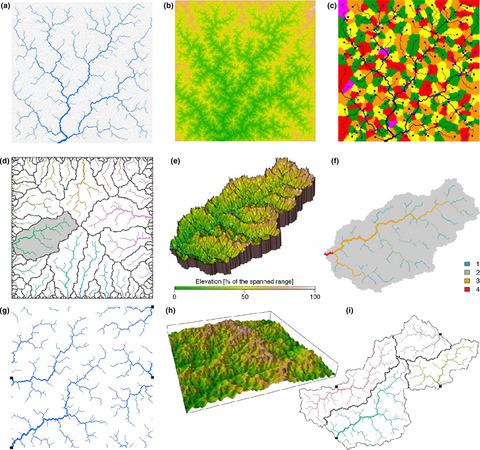当前位置:
X-MOL 学术
›
Ecol. Evol.
›
论文详情
Our official English website, www.x-mol.net, welcomes your feedback! (Note: you will need to create a separate account there.)
Generation and application of river network analogues for use in ecology and evolution.
Ecology and Evolution ( IF 2.6 ) Pub Date : 2020-06-30 , DOI: 10.1002/ece3.6479 Luca Carraro 1, 2 , Enrico Bertuzzo 3 , Emanuel A Fronhofer 4 , Reinhard Furrer 5 , Isabelle Gounand 1, 2, 6 , Andrea Rinaldo 7, 8 , Florian Altermatt 1, 2
中文翻译:

用于生态和进化的河网类似物的产生和应用。
更新日期:2020-07-30
Ecology and Evolution ( IF 2.6 ) Pub Date : 2020-06-30 , DOI: 10.1002/ece3.6479 Luca Carraro 1, 2 , Enrico Bertuzzo 3 , Emanuel A Fronhofer 4 , Reinhard Furrer 5 , Isabelle Gounand 1, 2, 6 , Andrea Rinaldo 7, 8 , Florian Altermatt 1, 2
Affiliation

|
- Several key processes in freshwater ecology are governed by the connectivity inherent to dendritic river networks. These have extensively been analyzed from a geomorphological and hydrological viewpoint, yet structures classically used in ecological modeling have been poorly representative of the structure of real river basins, often failing to capture well‐known scaling features of natural rivers. Pioneering work identified optimal channel networks (OCNs) as spanning trees reproducing all scaling features characteristic of natural stream networks worldwide. While OCNs have been used to create landscapes for studies on metapopulations, biodiversity, and epidemiology, their generation has not been generally accessible.
- Given the increasing interest in dendritic riverine networks by ecologists and evolutionary biologists, we here present a method to generate OCNs and, to facilitate its application, we provide the R‐package OCNet . Owing to the stochastic process generating OCNs, multiple network replicas spanning the same surface can be built; this allows performing computational experiments whose results are irrespective of the particular shape of a single river network. The OCN construct also enables the generation of elevational gradients derived from the optimal network configuration, which can constitute three‐dimensional landscapes for spatial studies in both terrestrial and freshwater realms. Moreover, the package provides functions that aggregate OCNs into an arbitrary number of nodes, calculate several descriptors of river networks, and draw relevant network features.
- We describe the main functionalities of the package and its integration with other R‐packages commonly used in spatial ecology. Moreover, we exemplify the generation of OCNs and discuss an application to a metapopulation model for an invasive riverine species.
- In conclusion, OCNet provides a powerful tool to generate realistic river network analogues for various applications. It thereby allows the design of spatially realistic studies in increasingly impacted ecosystems and enhances our knowledge on spatial processes in freshwater ecology in general.
中文翻译:

用于生态和进化的河网类似物的产生和应用。
- 淡水生态学的几个关键过程受树枝状河网固有的连通性支配。从地貌学和水文学的角度对这些问题进行了广泛的分析,但是传统上在生态模型中使用的结构不能很好地代表真实流域的结构,常常无法捕获天然河流的众所周知的缩放特征。开拓性工作将最佳渠道网络(OCN)确定为跨越树,再现了全球自然流网络的所有缩放特征。尽管已使用OCN来创建用于种群,生物多样性和流行病学研究的景观,但通常无法获得它们的产生。
- 鉴于生态学家和进化生物学家对树突河流网络的兴趣日益浓厚,我们在这里提出一种生成OCN的方法,为了促进其应用,我们提供了R-package OCNet。由于生成OCN的随机过程,可以构建跨越同一表面的多个网络副本。这允许执行计算实验,其结果与单个河网的特定形状无关。OCN构造还可以生成源自最佳网络配置的海拔梯度,该海拔梯度可以构成用于陆地和淡水领域空间研究的三维景观。此外,该软件包还提供了将OCN聚合到任意数量的节点,计算河流网络的多个描述符以及绘制相关网络功能的功能。
- 我们描述了包装的主要功能及其与空间生态学中常用的其他R包装的集成。此外,我们举例说明了OCN的生成,并讨论了对入侵河流物种的亚种群模型的应用。
- 总之,OCNet提供了一个强大的工具,可以为各种应用生成逼真的河网模拟。因此,它可以设计在日益受到影响的生态系统中进行空间现实研究,并增强我们对淡水生态学中空间过程的总体了解。



























 京公网安备 11010802027423号
京公网安备 11010802027423号